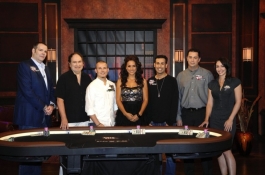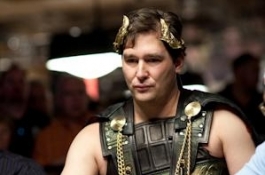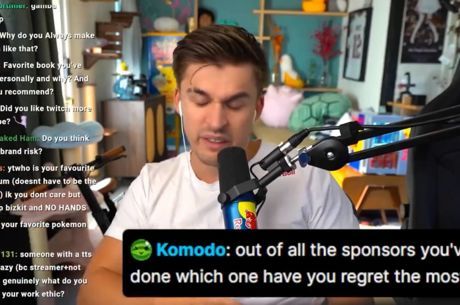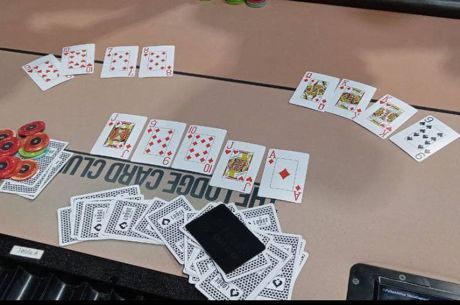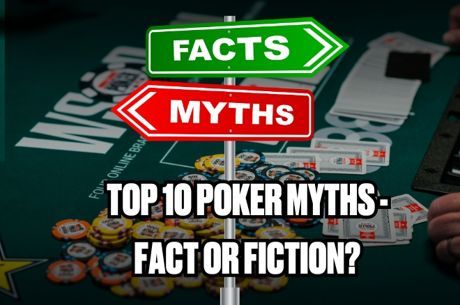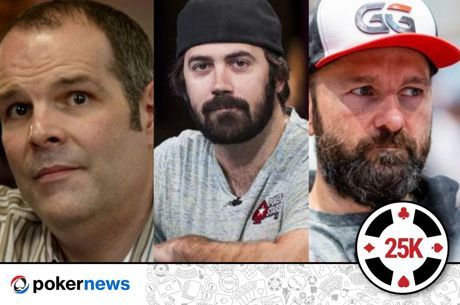PokerNews Top Five: Prop Bets
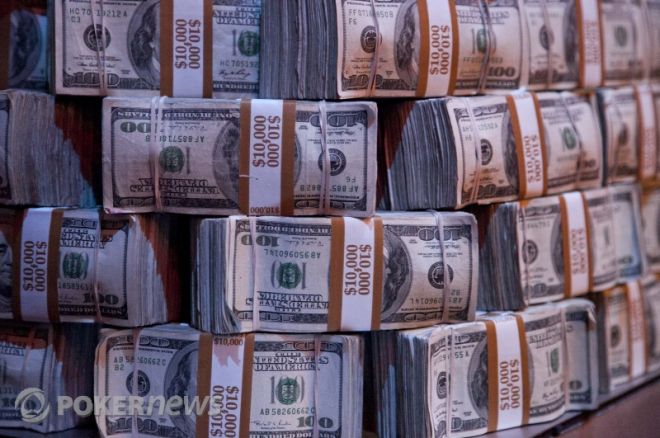
Prop betting seems to be engrained into the very core of our poker culture. Everywhere you look, someone is dressing up like Julius Caesar, sculpting hair into shapes, piercing, tanning, shaving, or tattooing something. All for a buck or a million. Poker author Michael Craig realizes that gamblers tend to fill even their nonpoker time with more gambling. "If they are home watching TV, they bet sports. If they are driving through the rain, they bet on how long it will take a raindrop to reach the bottom of the car��s window. They want to have gambling in every aspect of their lives.��
At the poker table, prop bets have become part of the game. Everywhere you look, someone is handing over a couple of $100 bills after a buddy (or a complete stranger) correctly guessed the flop color, or threw a water bottle into a trash can from their seat, or stood up and sang, "I'm a little teapot" in front of everyone, or won an actual coin flop, for that matter. Plenty of players have bet six figures on coin flips. Huck Seed once bet that (at 6'7" tall) he could learn to do a standing backflip in two months. He did it. Seed is a prop-bet fiend, in fact. He bet Phil Hellmuth $50,000 that he could stand in the ocean up to his shoulders for 18 hours straight. He failed. Jon Hennigan once made a six-figure bet that he could move to Des Moines, Iowa, for six weeks. He lasted two days. Joe Sebok, Jeff Madsen, and Gavin Smith had a last-longer bet that involved getting tattoos of the other players' faces �� like, permanently. Andrew Robl paid Jay Kwik $40,000 to live in a Bellagio bathroom for 25 days.
Pride and big stacks of cash change hands during these prop bets, and we've got a quick rundown of some of the most memorable.
#5: Phil Ivey; Go Vegetarian for a Million Dollars
High Stakes Poker has spawned some of the most expensive prop bets we've seen on television. In season six, a conversation started at the table with Phil Ivey, Tom "durrrr" Dwan, Gus Hansen, Daniel Negreanu, and Eli Elezra. Ivey was looking for some action on a bet that he could give up eating all meat for a full year. ��I was thinking about doing it for a while, so this is kind of like an added incentive," he said. Dwan mentioned that he'd be willing to bet "a bit," and Ivey tried to pin him down for $5 million. Dwan was thinking more like $500,000, but that wasn't in the ballpark. "I'll try it for two million," Ivey shrugged. It was still too much for Dwan.
Eventually, Ivey bottom-lined. "I'll do it for a million. I can't do it for less than that. I'm going to lose. I know I'm going to lose. I'm going to be begging to settle in, like, 4 days." Book it. A million dollars to go vegetarian for a year �� or $2,740 per day if you're scoring at home.
In an interview a later, Kara Scott talked to both players about the prop. "I like my side," Dwan said flatly. "Steak can be tasty sometimes."
"Is it something that you could do?" she asked him.
"For a million dollars?" Dwan considered. "No. Definitely not." When asked what his number was, Dwan answered, "Shoot me three or four and I'll start considering."
Ivey talked about how it's always sweeter to take Dwan's money. ��He thinks he��s stealing right now. He thinks I have no shot at doing it�� He��ll learn the hard way.�� Returning to the tables, Ivey proceeded to foreshadow some of the suspense that would unfold a few months later at the 2010 World Series: "Let's do some bracelet bets now while we're on it."
The result of the vegetarian bet? Twenty days later, Ivey bought out for the friendly fee of $150,000.
You can watch the video of the bet on High Stakes Poker here, starting at the 28:00 mark.
#4: Erick Lindgren; Play Four Rounds of Golf for $340,000
You know how these things start. You're at the bar with a couple of buddies. One of you brings up your plans for a golf weekend. The others start telling stories about how badly you play. Then, you make some ridiculous claim to defend your honor and have to follow through with it. It shows up on Wikipedia a few weeks later.
That's sort of what happened to Erick Lindgren when he got himself involved in a golf bet with Gavin Smith, Chris Bell, and Phil Ivey. During the 2007 WSOP, Lindgren claimed he could play four rounds of golf from the pro tees at the pro-level "Bear's Best" course in one day, break 100 in every round, and do it while walking and carrying his own clubs. The opposition agreed to his bet for a total of $340,000, on the condition that they could pick the day.
And so, at a very hot 5:45 a.m. day in June, Lindgren set off on the first tee. If the morning was already hot, the afternoon was sweltering. The course is 7,194 yards long from the tips, and walking four rounds would require at least 16 miles of hill climbing and club carrying in the midsummer Las Vegas sun. With two rounds under his belt, the midday heat became a big force against Lindgren, and he experienced symptoms of heat exhaustion and dehydration. He needed to break often, lay down and rest. He'd go on to lose about 15 pounds over the course of the day, but he was on pace with three sub-100 rounds behind him as the day's heat began to peak.
Lindgren had to finish his rounds before sunset, and he was walking up the fairway with an orange glow behind him as the clock approached 8:00 p.m. Just as the last few minutes of sun were running away from him, Lindgren sunk his putt on the 72nd hole to collect the bet, by far his biggest cash of that WSOP.
Check out video footage of the bet from RawVegas.
#3: Ted Forrest; Lose 48 pounds for $2 million
There's some history to this bet. During the 2007 WSOP, Mike Matusow and Ted Forrest got into a discussion about Matusow's weight. Apparently, Mike "the Mouth" weighed 181 pounds in his high school prime, but he was a beefy 241 at the time of the conversation. Forrest put down $100,000 that said Matusow couldn't get back to that weight before the 2008 WSOP, and Matusow accepted the challenge.
Matusow changed his entire lifestyle, hired a trainer, and got to work. He was still 15 pounds away from his goal with nine days to go, but Matusow starved and jacuzzi'd his way to a narrow win, weighing in at 180.8 pounds.
Fast forward. At the Commerce Casino, on May 5, 2010, Matusow and Justin "BoostedJ" Smith turned the tables. Forrest, who was formerly quite an athlete, was up to 188 pounds himself after a big dinner, and it was time for some more prop action. Forrest bet $50,000 that he could get his weight below 140 pounds by September 15 of that year, and Matusow and Smith gave him 20:1. Even better, they gave him another 10:1 on $100,000 that he couldn't pull it off before July 15. Forrest was putting up $150,000 for a chance at a very skinny waistline and an obese $2 million paycheck.
The accounts of Forrest's pursuit of his goal as told by Michael Craig are some of the great pieces of recent poker writing. There was a certain good-naturedness about the bet that was astounding given the money involved. Justin had room service deliver huge cakes and steaks to Ted at the poker table. Ted joked that if he lost consciousness cutting weight, he wanted Justin to put his body on a scale. Just as was the case in the reverse bet with Matusow in 2007, Forrest was sweating it right down to the wire.
But Matusow was the one doing most of the sweating. On July 12, he aired his sorrows on Facebook: "Great deal. Ted Forrest is down to 142.6. Has 3 days to hit 139.9. Should be NP. He hasn��t eaten in 9 days he says. Good bye 2 million."
Forrest continued to fast for another day, often bypassing sleep in favor of constant motion to burn whatever shards of calories he still had left in his body. On July 13, he stepped onto the stage in the Pavilion at the Rio just after the last Main Event tables had been broken into the Amazon Room on Day 4. There was a scale on the floor and an ESPN camera crew encircling the weigh-in, and the whole world got to see the number on the digital screen: 138.0.
Ted Forrest was ghastly thin, but he was $2 million richer �� two days early.
#2: Ashton Griffin; Run 70 miles in 24 hours for $300,000
Our runner-up is the prop bet that sparked this little article here, and one that has sparked a lot of conversation around the poker table in the last couple of weeks. It all started with a simple challenge, but it ended with a lot of drama and a unique juxtaposition of real life and poker life that exploded through poker forums and social media.
On the morning of Friday, February 4, Ashton Griffin, a 22-year-old poker pro, sat in his Orlando home trying to book an insane bet. Griffin said he could run 70 miles in 24 hours. On the listening end of the phone was Justin "BoostedJ" Smith, and he and Griffin were trying to hash out a good number. Even with Griffin laying 5:1, Smith wasn't giving any action, and it looked like the bet had stalled. Griffin was pleading for a taker, though, and his roommate Haseeb "INTERNETPOKERS" Qureshi agreed to put up $70,000 to Griffin's $210,000 to make the bet a go. Those numbers would eventually swell to $285,000 and $855,000, respectively, as Griffin continued to bargain even while the bet was taking place.
On the heels of a long night out, possibly hungover, and definitely working on just a few hours of sleep by all accounts, Griffin quickly threw on a pair of running shorts and jogged to the nearby gym to start the bet. Beginning at 12:30 that afternoon, he was given a span of 24 hours to complete the run. He had to maintain a running speed at all times with anything below that given speed not counting toward his total mileage. He was also free to take as many breaks as he needed. Griffin has a background in cross-country running and wrestling and is incredibly fit according to his friends. Still, 70 miles��
The 24 hours that followed were filled with Power Bars and Gatorade for Griffin, and drama and second-guessing for everyone else involved. Qureshi worried about the physical dangers involved, and Griffin's parents even drove up from Ft. Lauderdale to put an end to it. But Griffin would not be swayed. He ran on and on, only taking short breaks to run home and grab some carbs or a quick stretch. With his body apparently bent to its absolute limit, Griffin finally stepped off the treadmill 23 hours 15 minutes later with 70 miles under his heels and $300,000 in his pockets.
If you're interested in hearing what Ashton Griffin had to say about his million-dollar prop bet, check out the PokerNews Podcast from late last week where he discusses things.
Twitter exploded. Justin Smith had ended up taking some action on Griffin's side in the end, and he was one of the first to break the news: ��A very big/insane prop bet just came to conclusion. I booked action on @arfarfhowl to be able to run 70 miles in 24-hour window. Ding we win! He just completed it with 45 minutes to spare�� He��s so sick!��
The fallout from that bet has already made several laps around the debate desks with many people taking the position that prop betting can be dangerous and bad for the game of poker. This isn't the place to take a position on either side of that discourse, but you can't argue that Griffin's feat is a remarkable one. Put a few hundred thousand dollars behind it, call it a "prop bet," and you've got our number two of all time. For now.
#1: Phil Ivey; Win two bracelets in two years for $5 million
Sure, if we're talking bracelet bets, we could have included Tom Dwan's big array of wagers for the next three years. But they're spread out over many players, and the exact figures are hard to nail down. The personal nature and the staggering sum of this particular prop bet is what puts it at the top of our list. $5 million. Straight up.
As with Dwan, it's difficult to sort out the actual details through all of the inflammatory rumors. In early 2010, Howard Lederer and Phil Ivey made this little $5 million even-money bet that says Ivey can't win two bracelets during the next two years. The terms of the bet also stipulate that if one of the two bracelets comes at the WSOPE, the bet is a push. For a given year, the bookies have Ivey as about a 4:1 dog to win a bracelet, and Ivey puts himself at about 40:1 to win a particular event when he plays. With the math, Ivey should play right around 80 events over the course of the 2010-2011 WSOPs. He needs to score two wins in those 80. If you'll, ahem, recall his double bracelet performance in 2009, he has won three bracelets in the last two years. And Lederer made the bet following that 2009 heater.
What the $5 million bet means for the bankrolls of Ivey and Lederer is not insignificant, but it certainly won't do any severe damage to their means of making a living one way or the other. What it means for the poker fan, however, is rather significant as they continue to turn the enigmatic Ivey into poker's superhero. Perpetuating those sentiments, a recharged and remotivated Ivey wasted no time getting back to work chasing bracelets. He paced himself with two early cashes in the 2010 WSOP, then narrowly missed a final table with a 12th-place finish in the $2,500 PLH/PLO event. Then, on June 19, 37 events into the series, Ivey broke through and and snagged bracelet number one with a victory in the $3,000 H.O.R.S.E. event. How much was first place? "I have no idea," Ivey admitted to the cameras. Somewhere, Howard Lederer poured himself a tall shot of whiskey.
Ivey's bracelet chase then took him to London in September to try to guarantee himself a freeroll with another bracelet at the WSOPE. Ivey cashed in the High Roller Heads-Up event, but Gus Hansen sent him away in the Round of 16 on the way to claiming his own first bracelet. There was still the Main Event left, however, and four days into it, Ivey was still in contention. His final day was a short one, however, and he exited in 19th place, hedging his prop bet by a paltry ��26,400. Close but no cigar.
The best part of this high-stakes prop bet is that it's only half over. At the midway point of their $5 million gamble, Ivey is on pace to win. Apart from the Lederer bet, rumor has it that Ivey has several more millions in action with other players, and we'd probably all be a bit shocked by the actual numbers involved. As soon as the money bubble bursts in a WSOP event, everyone suddenly wants to know whether or not Ivey has chips. Heaven help us when he makes his first final table of the 2011 summer. And you know there will be at least two or three late nights inside the Rio where all those guys will have to stand together in a dim corner sweating Ivey as he plods along deeper and deeper into some $1,500 donkament. It's $200,000 to first. Plus $5 million.
We don't know how this will all shake out, but we do know enough not to break the Cardinal Rule of poker. You don't bet against Ivey.
As always, follow us on Twitter and like us on Facebook for the best up-to-the-minute news.

